Reseña del libro "Career as a Cardiovascular Technologist (en Inglés)"
DO YOU ENJOY HELPING PEOPLE? Would you like to work with state-of-the-art technology? Are you interested in a profession in a skyrocketing segment of the allied healthcare field? These attractive features and many more, characterize the burgeoning specialty of Cardiovascular Technology. Employment of CVTs is expected to increase by a whopping 25 percent within the next decade. A trio of factors account for this career's upward trajectory, two of which are related to the aging population: the Baby Boom generation, 76 million strong, started turning 60 in 2007. People are living longer, thanks to continual advances in healthcare and medicine. The third factor is distressing: Americans, generally, do not take good care of their own health. Heart disease is a phenomenon of the modern age. In pre-industrial societies, most people's livelihoods consisted of manual labor. Domestic life involved vigorous activity by men, women, and even children. Before people had access to manufactured products and the conveniences of modern life, they were largely self-sufficient. American pioneers cut down trees for firewood, built their own and their neighbors' houses, repaired their own roofs, hunted for food, drew water from the well, churned milk into butter, harvested crops, sheared sheep, slaughtered their own livestock, played stickball and hopscotch, and walked to school. Tobacco and sugar were luxuries for most people, who had little discretionary spending money and lived far from the general store, if there was one. Food was plentiful at harvest time, but scarce in the winter. Today, our homes are heated and cooled with the flick of a switch. Water flows through our taps, our food comes from the supermarket, and high-tech entertainment devices have replaced physical activity as young people's recreation of choice. Those who are old enough to purchase them easily obtain tobacco and alcohol. Foods laden with sugar, salt and fat are readily available at chain restaurants, as prepared frozen meals, and right off the shelf in the form of chips and other savory snacks. We do not walk to the corner store anymore, because there is not one. Instead, we drive to the mall. If we want to exercise, we go to the gym. Nevertheless, mostly we sit on the couch in front of the TV or in a chair in front of the computer screen. All of these dietary and lifestyle factors contribute to conditions implicated in heart disease, including high blood pressure, obesity, atherosclerosis (narrowing of the arteries that obstructs blood flow to the heart), and elevated levels of cholesterol, the soft, waxy substance that builds up in the blood, causing atherosclerosis. Hypercholesterolemia may sometimes be an inherited condition, but often it is related to excessive consumption of saturated fat and dietary cholesterol. According to the American Heart Association, coronary heart disease is the leading cause of death in the United States, and stroke is the third leading cause of death. What can a cardiovascular technologist do to help alleviate these terrible healthcare problems? Working under the direction of a cardiologist (heart specialist) or other medical doctor, the CVT performs procedures on patients that are used in the diagnosis and treatment of cardiac (heart) and peripheral vascular (blood vessel) diseases. Data are collected from these procedures and interpreted by the doctor to determine the presence and degree of heart disease. Other duties may include reviewing and recording patients' medical histories, scheduling appointments, and recording into a database the physician's assessments of the diagnostic findings. Intrigued? This report tells you all about exploring and preparing for a job in cardiovascular technology, what kind of education is required, what you will earn, benefits and drawbacks to this work, and everything else you need to know about a career centered on that magnificent muscle, the heart!

